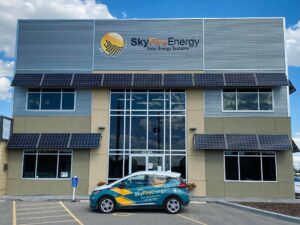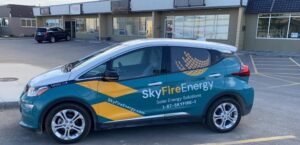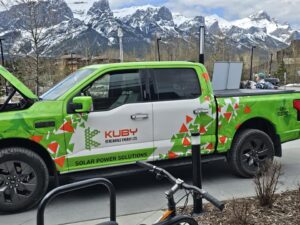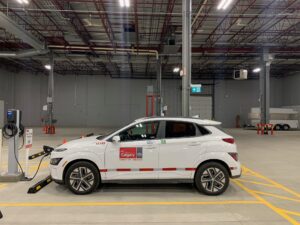In this feature, we reached out to Alberta based companies that have made the strategic decision to purchase electric vehicles for their fleet as part of their business operations. By this, we hope to share valuable insights into the evolving landscape of sustainable transportation here in Alberta.
We can gain valuable knowledge about the practical considerations, challenges, and benefits associated with transitioning to electric fleets, thereby informing future strategic decisions and fostering a more sustainable business ecosystem.
Company EV Fleet Profiles
Prestige Electric My Garage Auto & Tire Gasonic Group SkyFire Energy Inc ATCO Electric
Mayland Appliances City of Calgary Trico Group Kuby Energy

Tesla Model X
Electric Vehicle Fleet Profile: Artem Valchkov from Prestige Electric
Operation Locations: St Albert & Calgary
EVAA: What were the primary factors or considerations that led your company to decide to incorporate electric vehicles into your fleet?
PE: To us, EV’s are more than a vehicle – it is a way of life. By going electric with our fleet we are taking conscious action to support, practice and participate in the eco-friendly momentum that is building across the world.
EVAA: How do electric vehicles align with your company’s values and sustainability goals?
PE: We LOVE this question! Do you mean, aside from electrification being the way of the future and aligning with OUR vision? We love that the leaders in the EV industry are forward-thinking; their obsession with improvement and innovation results in not only that these vehicles are powered by more eco-friendly means, but they are also breaking the mold on how things are built/done. So are we!
EVAA: What specific benefits do you anticipate gaining from transitioning to electric vehicles, both in terms of cost savings and environmental impact?
PE: Leading by example is important, and we are proud to be at the forefront of this transition. Aside from the exponential savings on costs of fuel which are reinvested back into our clients and quality of our service, we can also sleep at night knowing that our impact on the environment is dramatically reduced.
EVAA: Were there any challenges or obstacles you faced in the process of integrating electric vehicles into your fleet, and how did you overcome them?
PE: Of course. We are still waiting on a great solution for a van with range. This is a challenge for us with switching our whole fleet over. We are patient, and will undoubtedly do so, in good time. There are also always power constraints within electrical services. They have the capacity, but likely didn’t plan for the electrification and the relevant infrastructure. We are so lucky to have great partners in the energy management field. EV charging – thanks to them – can happen anywhere!
EVAA: How do you plan to manage the infrastructure and charging needs for our electric vehicles to ensure smooth operations and maximize efficiency?
PE: We are Alberta’s leader in EV charging installations. Part of this responsibility is staying on top of products and advancements. Researching, testing, and stocking the best for our clients. Again I would thank our partners. It’s a group effort!
____________________________________________________________________________________________________________________________
Electric Vehicle Fleet Profile: Chris Dekker company owner at My Garage Auto & Tire
Operation Location: Airdrie
EVAA: What were the primary factors or considerations that led your company to decide to incorporate electric vehicles into your fleet?

Chevrolet Bolt EV
CD: We are an automotive service centre and operate 6 EVs as courtesy cars (for clients to use while their vehicle is with us) plus one EV as a shuttle vehicle. Our main reason for choosing electric vehicles was to reflect our positioning as an industry leading, future-focused business. We operate a very advanced shop with some amazing hybrid/EV capability and we wanted the cars to reflect that.
EVAA: How do electric vehicles align with your company’s values and sustainability goals?
CD: Our second reason for choosing electric vehicles was exactly this – sustainability. We’re working to stand out as a green example in a dirty industry through initiatives like diverting over 90% of our waste, or donating a portion of every invoice to environmental charities. Electric vehicles align perfectly with that goal.
EVAA: What specific benefits do you anticipate gaining from transitioning to electric vehicles, both in terms of cost savings and environmental impact?
CD: Because we’ve been operating a growing fleet of EVs for 5 years now, we’re already seeing all sorts of benefits. Our cars are all used locally and therefore don’t need to visit DC fast chargers, so the charging costs less than half of what gasoline would. The cars also require less maintenance, though it’s worth mentioning that electric vehicles are not maintenance-free, which seems to be a common misconception. Our clients enjoy the responsive acceleration and low centre of gravity offered by an EV, plus they love not having to stop at a gas station before they return the courtesy car.
EVAA: Were there any challenges or obstacles you faced in the process of integrating electric vehicles into your fleet, and how did you overcome them?
CD: The only challenges that we’ve had to navigate so far surrounded actually purchasing the cars. All cars have been in short supply over the past few years, but electric cars have been especially hard to come by. On top of that – as many others have experienced – dealerships in Alberta don’t seem particularly motivated to sell EVs and salespeoples’ product knowledge is often quite poor. When shopping for our first Chevrolet Bolt in 2020 we were asked, “Are you sure you don’t want a Trax? We have lots of those and it’s kind of the same car, without the hassle of charging it.” If you’re rolling your eyes right now, that makes two of us.
EVAA: How do you plan to manage the infrastructure and charging needs for our electric vehicles to ensure smooth operations and maximize efficiency?
CD: Because our vehicles are in use all day and parked during the night, we charge them in the evenings. We have installed level 2 chargers on site to accomplish this. Even at a low 5-7 kW (20-30 amp) charge rate, the cars are still fully charged well before we arrive in the morning.
Everyone loves leaving the business with a “full tank” every morning and not having to stop throughout the day.
Electric Vehicle Fleet Profile: Kae Shummoogum Founder & CEO Gasonic Group
Operation Location: Calgary

Gasonic Group EV Fleet
EVAA: What were the primary factors or considerations that led your company to decide to incorporate electric vehicles into your fleet?
KS: The main reason for going electric is that my company is involved in monitoring indoor pollution in a thousand parkades. We realized through research during the pandemic that air pollution kills 7 million people a year and affect the health of billions. We decided in 2003 to limit our pollution impact and switch to hybrid vehicles wherever possible. We bought a Prius plug-in-hybrid in 2015 and bought an EV Bolt in 2023 after seeing a few companies using the Bolt for their fleet. The price had come down that we can also justify the cost.
EVAA: How do electric vehicles align with your company’s values and sustainability goals?
KS: Our sustainability goals was to become both net zero pollution and net zero emissions ahead of most companies. Fuel for our EV’s are easily produce by solar panels. By spring this year we will install 70 solar panels which allow us to produce 90% of our electricity and fuel for 4 EV’s.
EVAA: What specific benefits do you anticipate gaining from transitioning to electric vehicles, both in terms of cost savings and environmental impact?
KS: There are significant tax savings from my Tesla Model S (with free charging), which I own personally but drive mostly for business. The allowable mileage deduction is 50 cents per kilometer, but with the lower operating and maintenance costs for an EV, I save over $600.00 a month tax-free. Legally, of course!
My company monitors indoor air pollution from gas and diesel vehicles in parkades to control ventilationfor the health and safety of occupants. Promoting clean air has been our mission since 2003, and we transitioned to hybrid, PHEV, and fully electric vehicles 10 years ago. Our biggest environmental impact is through our mobile educational sessions at the Mayor’s Environmental Expo. This year, we taught 1,000 kids about clean air and saving money by driving electric.
EVAA: Were there any challenges or obstacles you faced in the process of integrating electric vehicles into your fleet, and how did you overcome them?
KS: The one challenge that we never anticipated was the fact that some employees are totally against EV. Our field technician quit as soon as he had to drive the vehicle out of town. Be sure the employees are on board. The other major challenge was the fact condo board for our office building block our expansion of EV chargers so we are limited in expansion. We have installed a smart charging control system for expansion whenever the condo board approves our infrastructure expansion.
EVAA: How do you plan to manage the infrastructure and charging needs for our electric vehicles to ensure smooth operations and maximize efficiency?
KS: When I bought my first EV, we installed solar panels and a charger at home. However, when we bought a second EV, home charging became a challenge. So, we installed 29 solar panels on the office roof and were pleasantly surprised to discover that it takes only six solar panels to charge a car for the average driver in Calgary. Our yearly production is equivalent to 100,000 kilometers of pollution and emissions-free driving. The advantages of having solar power chargers at the office instead of at home include:
- 100% tax-free benefits
- Daytime charging takes advantage of the sun
- Making a strong ESG statement

Chevrolet Bolt EV at Skyfire Energy Calgary
Electric Vehicle Fleet Profile: Stacy Haakonson, VP RevOps, Employee Owner, SkyFire Energy Inc
Operation Location: Calgary & Edmonton

Chevrolet Bolt EV
EVAA: What were the primary factors or considerations that led your company to decide to incorporate electric vehicles into your fleet?
SH: We decided to transition our fleet to electric vehicles primarily due to our commitment to sustainability, cost savings potential, regulatory compliance, brand image enhancement, and advancements in EV technology. These factors align with our mission to reduce carbon emissions and commitment to Net-Zero by 2030, achieve long-term financial benefits, adhere to regulations, enhance our brand reputation, and leverage cutting-edge technologies.
EVAA: How do electric vehicles align with your company’s values and sustainability goals?
SH: As B Corporation, electric vehicles align perfectly with SkyFire Energy’s values and sustainability goals. By incorporating EVs into our fleet, we actively reduce our carbon footprint and promote clean, renewable energy solutions. This commitment to sustainability resonates with our core values of environmental stewardship and innovation, helping us lead by example in the transition to a more sustainable future.
EVAA: What specific benefits do you anticipate gaining from transitioning to electric vehicles, both in terms of cost savings and environmental impact?
SH: Transitioning to electric vehicles offers many benefits for SkyFire Energy. Firstly, we anticipate significant cost savings due to lower operating and maintenance expenses associated with EVs compared to traditional vehicles. Additionally, by reducing our reliance on fossil fuels, we’ll contribute to a cleaner environment, lower carbon emissions, and align our operations with our commitment to sustainability. This transition enhances our bottom line and reinforces our role as environmental leaders in the renewable energy industry.
EVAA: Were there any challenges or obstacles you faced in the process of integrating electric vehicles into your fleet, and how did you overcome them?
SH: While integrating electric vehicles into our fleet, we encountered several challenges, including initial infrastructure investments, range anxiety, and ensuring adequate charging infrastructure. However, we overcame these obstacles through careful planning, investing in charging infrastructure for our fleet and employee training. Our commitment to overcoming these challenges underscores our dedication to embracing sustainable transportation solutions and driving positive change in our industry.
EVAA: How do you plan to manage the infrastructure and charging needs for our electric vehicles to ensure smooth operations and maximize efficiency?
SH: SkyFire has invested in charging stations at our facilities, implementing smart charging technology to optimize charging schedules and reduce demand peaks and providing training and resources to our staff for efficient use of EVs. We aim to ensure smooth operations and maximize efficiency across our electric vehicle fleet by prioritizing infrastructure development and proactive management.
Electric Vehicle Fleet Profile: William York P.Eng Senior Engineer | Emobility | ATCO Electric
Operation Location: Calgary, Red Deer, Edmonton
EVAA: What were the primary factors or considerations that led your company to decide to incorporate electric vehicles into your fleet? How do electric vehicles align with your company’s values and sustainability goals?
WY: Electric vehicles are a natural fit for an electric utility. Beyond that we have ambitious sustainability targets and, although our vehicle fleet doesn’t represent a large portion of our emissions, we believe that decarbonizing our transportation emissions is the right thing to do.
EVAA: What specific benefits do you anticipate gaining from transitioning to electric vehicles, both in terms of cost savings and environmental impact?
WY: In 2022 we developed a strategy to understand the electrification potential of our fleet. This study does point to the possibility of meaningful emissions reductions and cost savings but there are also considerable outfitting costs for charging infrastructure that need to be taken into account.
EVAA: Were there any challenges or obstacles you faced in the process of integrating electric vehicles into your fleet, and how did you overcome them?
WY: ATCO Electric has the largest service area of any electric utility in Alberta and this comes with the need for EVs with longer ranges per charge and more DC fast charging infrastructure than others would require.
EVAA: How do you plan to manage the infrastructure and charging needs for our electric vehicles to ensure smooth operations and maximize efficiency?
WY: One thing that we have noticed so far with our fleet of sixteen EVs is that they tend to be finished charging each day at around 10AM or 11AM yet remain parked until the end of the workday. This suggests that we can look into reducing our charging output which will minimize demand on the grid in the morning. However we also have to consider that eventually we will have operational vehicles that need a charge quickly.
____________________________________________________________________________________________________________________________
Electric Vehicle Fleet Profile: Mayland Appliances, Silvanus McKinley, Office Manager
Operation Location: Calgary
 EVAA: What were the primary factors or considerations that led your company to decide to incorporate electric vehicles into your fleet?
EVAA: What were the primary factors or considerations that led your company to decide to incorporate electric vehicles into your fleet?
SM: The main thing that drove us to have all our company vehicles be electric, is the cost comparison for gas vs electricity to power our vehicles. At the moment we have 3 electric vehicles on the road. Two Chevrolet Bolts that have been converted into fully functioning service vans, and we just recently purchased a Ford F-150 Lightning Which has greatly increased the amount of work; and types of work we can do. When we first started our business in 2020 we were spending at least 1000$/month on gas alone to power a Ford F-150. The owner of the business had owned a Chevrolet Volt back when they were first introduced and this inspired him to make the swap back to electric vehicles for Mayland Appliance Repair.
EVAA: How do electric vehicles align with your company’s values and sustainability goals?
SM: We recognise how much emissions are produced by mobile repair companies and contractors on a day to day basis. Not only this, but also the sheer amount of waste that the trade produces as well. We strive to be as sustainable as possible in our business practices and our electric vehicle fleet is the main way we can continue doing this.
EVAA: What specific benefits do you anticipate gaining from transitioning to electric vehicles, both in terms of cost savings and environmental impact?
SM: We’ve been operating for 3 years with our electric vehicle fleet and we see the impact and benefits every day. We’ve significantly cut down on our operating costs, and vehicle upkeep since we no longer need to worry about things like oil changes and fueling vehicles; among other common problems with putting hundreds of Kilometers on a vehicle with a typical engine. In turn our greenhouse gas emissions have been greatly reduced. I believe once larger corporations that rely on company vehicles see how much electric vehicles save on cost and emissions in the long run. We will see a much more positive outlook by the greater population towards electric vehicles.
EVAA: Were there any challenges or obstacles you faced in the process of integrating electric vehicles into your fleet, and how did you overcome them?
SM: I’d say the only Challenge we really have is installing charging stations at our employees residences since we’re a small business that is currently operating out of a residential building. We are able to charge all 3 vehicles at once. There is the occasional issue with having to travel out of town. Depending on where a client is located outside the city, finding charging stations can sometimes be a struggle. But so far we have been able to manage. The farthest we’ve traveled with our Chevorlet Bolts is Regina in Saskatchewan. Due to needing to stop to charge it was definitely a longer trip. But absolutely doable. Once more charging stations are built across Alberta and Canada as a whole, specifically in more rural areas; This will become less of a concern for all electric vehicle owners. Current and future.
EVAA: How do you plan to manage the infrastructure and charging needs for our electric vehicles to ensure smooth operations and maximize efficiency?
SM: We pay to have all our technicians have their own charging stations at their homes so this way we are able to ensure our fleet is ready to operate every day at maximum efficiency. All our vehicles have a minimum of 400km range on one charge, and that will have us covered for an entire day of service calls. We have experienced 0 downsides to this and we and our employees have been happy with this decision.
____________________________________________________________________________________________________________________________
Electric Vehicle Fleet Profile: KUBY Renewable ENERGY Ltd | Tygean Mungongo Marketing Coordinator
Operation Location: Calgary, Edmonton
EVAA: What were the primary factors or considerations that led your company to decide to incorporate electric vehicles into your fleet?
TM: As a leader in the renewable energy sector, Kuby aims to lead by example by transitioning our fleet to predominantly electric vehicles. We were able to install a solar system on-site which allows us to harness the energy generated by the solar modules to charge our EVs at essentially no cost. It made switching to EVs a no-brainer for us.
EVAA: How do electric vehicles align with your company’s values and sustainability goals?
TM: EVs play a huge part in our business. We are always looking to promote alternative energy solutions to our customers and EVs are an excellent way to reduce your environmental impact by lowering your reliance on fossil fuels. Not only do we use EVs within our own fleet, but we also install EV chargers in many of our customer’s homes. EVs help lower our overall carbon footprint, which is one of our main goals here at Kuby.
EVAA: What specific benefits do you anticipate gaining from transitioning to electric vehicles, both in terms of cost savings and environmental impact?
TM: By transitioning to electric vehicles, our company will save a substantial amount on fuel each year. This allows us to invest that money back into our business in the form of training, staff events, new equipment, and other areas to help our teams progress forward. Our EVs allow us to transport staff and our materials to the site each day without adding pollution to our environment. As a company dedicated to renewable energy, we recognize the importance of operating sustainably and prioritize eco-friendly practices in all aspects of our operations.
EVAA: Were there any challenges or obstacles you faced in the process of integrating electric vehicles into your fleet, and how did you overcome them?
TM: The only challenge our team has faced with EVs thus far is their limited battery range in the winter months. Besides that, our team has not had any major challenges to overcome with our new additions of EVs.
EVAA: How do you plan to manage the infrastructure and charging needs for our electric vehicles to ensure smooth operations and maximize efficiency?
TM: Luckily, we are fortunate to be in the renewable energy realm as a solar installer. This allowed us to install a solar system on our training roof which generates energy throughout the day to help power our office and charge our fleet of EVs when they arrive back at Kuby headquarters. Our company also installs solar EV chargers, so building these charging stations was not a daunting task for our team. This made the integration of EVs quite seamless.
Electric Vehicle Fleet Profile: Philippa Wagner, Green Fleet Program Manager, City of Calgary

EVAA: Why did your company decide to incorporate electric vehicles into your fleet?
The City of Calgary has been adding electric vehicles to our fleet to help reduce greenhouse gas emissions, modernize our fleet, and contribute to a sustainable future. It’s all part of our goal to create a climate-resilient, net-zero Calgary by 2050.
EVAA: How do electric vehicles align with your company’s values and sustainability goals?
PW: EVs fit perfectly with The City’s values of sustainability, innovation, and responsibility. By cutting emissions and leading by example, we’re making real strides toward our 2030 goal of reducing fleet emissions by 60 per cent and reaching net-zero by 2050.
EVAA: What benefits do you expect from transitioning to electric vehicles?
PW: Switching to electric vehicles will save money on fuel and maintenance while cutting emissions, leading to cleaner air and a healthier city. Plus, it strengthens our role as a sustainability leader in North America.
EVAA: Did you face any challenges integrating electric vehicles, and how did you overcome them?
PW: We did face a few bumps like supply chain delays and higher infrastructure costs, but we tackled these by planning ahead and focusing on projects where EVs were more suited for the application and readily available. It’s been a learning experience that’s set us up for smoother transitions in the future.
EVAA: How will you manage the charging needs for your electric vehicles?
PW: We’re rolling out a 10-year plan to build up our EV charging infrastructure, supported by partnerships with utility companies and smart charging technology to keep things running efficiently. We’re also using a capital funding program and participating in the Corporate Carbon Offset Program to support our sustainability goals.
____________________________________________________________________________________________________________________________
Electric Vehicle Fleet Profile: HR Manager Ana Pavic with the The Trico Group in Calgary.
EVAA: What were the primary factors or considerations that led your company to decide to incorporate electric vehicles into your fleet?
AP: The primary factors were vehicle usage, cost savings and environmental impact. Our Chevy Bolt is the main vehicle for our mobile security team. The primary factor for us going electric was the very high kms that the security team was putting on our other gas powered vehicles (i.e. 250kms per night) It has been a great cost saving in fuel and maintenance so far. We are anticipating a challenge as the lower temperatures start in the winter as the range will decrease, but we have created a charging strategy and we have our other vehicles on standby in case the team members need to switch it out on those -40 nights. Our F150 Hybrids are a new pilot we are testing in our construction department. The primary factor again was addressing fuel costs while choosing a vehicle that meets our business needs. Our field teams typically drive trucks or vans, are mobile from site to site and take their vehicle home at night. Charging the vehicles is our biggest challenge.
EVAA: How do electric vehicles align with your company’s values and sustainability goals?
AP: We are Western Canada’s only BCorp Certified Home Builder in Calgary and environmental & sustainable business practices are key factors in BCorp’s evaluation. Our commitment to doing things right goes back more than 30 years. With every home we’ve built – with every relationship we’ve entered – we’ve learned. We’ve applied the lessons and knowledge we’ve gained to develop a best practice, socially responsible approach that appliesto all aspects of our business. TRICO is an acronym for Trust, Respect, Integrity, Community and Opportunity, these are the values behind Trico Homes and provide our foundation as one of Calgary’s leading homebuilders. We want to be able to operate our business, but not at the expense of the environment. We source materials locally as much as possible and we look at how we can be sustainable in our work practices in all aspects of our business. The fleet is no different. The challenge with our fleet is that the employees take the vehicle home with them and their work locations are fluid, so moving to all electric fleets is not sustainable for us given we do not have a vehicle parking lot for the fleet where the trucks could be charged overnight.
EVAA: What specific benefits do you anticipate gaining from transitioning to electric vehicles, both in terms of cost savings and environmental impact?
AP: So far we have seen a 20% reduction in fuel costs on the F150 Hybrids which has been greater than what we anticipated. We will be adding more hybrids to the fleet next year as we switch out our older vehicles.
EVAA: Were there any challenges or obstacles you faced in the process of integrating electric vehicles into your fleet, and how did you overcome them?
AP: The biggest obstacle is the charging – for our Chevy Bolt we have Flo charges in our parkade and our parking at the head office. This works really well.
For our construction fleet members, they take the vehicles home at night and installing 50+ charging stations is not in the cards from a financial perspective and for any employee changes or turnover. So the hybrids seem to be a better fit.
EVAA: How do you plan to manage the infrastructure and charging needs for our electric vehicles to ensure smooth operations and maximize efficiency?
AP: I think for our currently use case, it is working well. We have chargers at each property and thissupports our current set up.